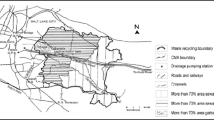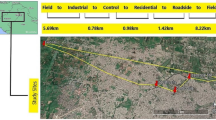Abstract
The disposal of industrial and sewage water is a problem of increasing importance throughout the world. In India, and most of the developing countries untreated sewage and industrial wastes are discharged on land or into the running water streams which is used for irrigating crops. These wastes often contain high amount of trace elements which may accumulate in soils in excessive quantities on long term use and enter the food chain through absorption by the plants. Among the trace metals, Cd has received the greater attention because of its easy absorption and accumulation in plants and animals to levels toxic for their health. The objective of this study conducted in three industrially different cities viz., Ludhiana, Jalandhar and Malerkotla was to monitor the extent of Cd accumulation in soils and plants receiving untreated sewage water. Plant and soil samples were collected from sewage and tubewell irrigated areas. Soil samples were analysed for texture, pH, EC, organic carbon (OC), CaCO3, bioavailable DTPA–Cd and plant samples were analysed for total Cd. In sewage irrigated soils, the mean values of pH were lower but organic carbon and electrical conductivity were generally higher both in surface and sub-surface layers of all the three cities as compared to tubewell irrigated soils. The mean DTPA- extractable Cd in sewage irrigated soil was 6.3- and 4.36-fold in Ludhiana, 3.38- and 1.71-fold in Jalandhar and 3.35- and 6.67-fold in Malerkotla in 0–15 and 15–30 cm soil depth, respectively, compared with the values in tubewell irrigated soils. The accumulation of DTPA–Cd in sewage irrigated soils was restricted to 30 cm depth after which the values were generally close to values in tubewell irrigated soils. Soil pH, OC, CaCO3, clay and silt collectively accounted for 37.1%, 65.1% and 53.9% DTPA-extractable bioavailable Cd in soils of Ludhiana, Jalandhar and Malerkotla, respectively. Lower R2 values in Ludhiana suggest that factors other than the ones mentioned may be affecting Cd availability. At all sites plants receiving sewage irrigation had elevated levels of Cd as compared to the plants receiving tubewell irrigation. The mean Cd content of sewage irrigated plants irrespective of the city was 5.96 μg g − 1 dry matter as compared to 0.98 μg g − 1 dry matter in tubewell irrigated plants. The results suggest that the intake of Cd obtained from consumption of crops grown on sewage irrigated soils would be much higher than the tolerable limits set by WHO and may, therefore, prove potentially toxic leading to various health ailments to humans and animals.
Similar content being viewed by others
References
Alloway, B. J. (1995). Heavy metals in soils 2nd Ed. Glasgow: Black Academic and Professional.
Anderson, A., & Nilsson, K. O. (1976). Influence of the levels of heavy metals in soil and plant from sewage sludge used as fertilizer. Swedish Journal of Agricultural Research, 6, 151–159.
Antoniadis, V., & Alloway, B. J. (2002). The role of dissolved organic carbon in the mobility of Cd, Ni and Zn in sewage sludge amended soils. Environmental Pollution, 117, 515–521.
Azad, A. S., Arora, B. R., Singh, B., & Sekhon, G. S. (1986). Pollution potential of municipal waste waters of Ludhiana, Punjab. Indian Journal of Ecology, 12, 1–7.
Chuodri, A. M., Allian, C. M. G., Barbosa-Jefferson, V. L., Nickolson, F. A., Chambers, B. J., & McGrath, S. P. (2000). A study of the impacts of Zn and Cd on two rhizobial species in soils of a long-term field experiment. Plant and Soil, 22, 167–179.
Elsokkary, I. H., & Lag, J. (1978). Distribution of different fractions of Cd, Pb, Zn and Cu in industrially polluted and non polluted soils of Odda Region Norway. Acta Agriculturae Scandinavica, 28, 262–268.
Gonzalez, R. C., Simunek, J., Sauve, S., & Adriano, D. (2006). Mechanisms and pathways of trace element mobility in soils. Advances in Agronomy, 91, 111–178.
Gray, C. W., Mclarcn, R. G., Roberts, A. H. C., & Condron, L. M. (1999). Solubility, sorption and desorption of native and added Cd in relation to properties of soils in New Zealand. European Journal of Soil Sciences, 50, 127–137.
Greger, M., Brammer, E., Lindsberg, S., & Idestam-Alamquist, J. (1991). Uptake and physiological effects of Cd in sugar beet (Beta vulgaris) related with mineral provision. Journal of Experimental Botany, 42, 729–737.
Hyun, H., Chang, A. C., Parker, D. R., & Page, A. L. (1998). Cadmium solubility and phytoavailability in sludge treated soil: Effects of soil organic carbon. Journal of Environmental Quality, 27, 329–334.
Jinadas, K. B., Milham, P. N., Hawlins, C. A., Cornish, P. S., Williams, P. A., Kaldor, C. J., et al. (1997). Survey of cadmium levels in vegetables and soils of Greater Sydney, Australia. Journal of Environmantal Quality, 36, 924–933.
Jing, J., & Logan, T. J. (1992). Effects of sewage sludge cadmium concentration on chemical extractability and plant uptake. Journal of Environmantal Quality, 21, 73–81.
Kansal, B. D., Kumar, R., & Sikka, R. (1996). Contamination of soil with sewage irrigation. Paper presented at the International Conference on Contaminants and Soil Environment in the Australasia Pacific Region, held from 18–23 February 1996 at Adelaide, Australia.
Lindsay, W. C., & Norwell, W. A. (1978). Development of a DTPA soil test for zinc, iron, manganese and copper. Soil Science Society of America Journal, 42, 421–428.
Liphadzi, M. S., Kirkham, M. B., Mankin, K. R., & Paulsen, G. M. (2003). EDTA-assisted heavy metal uptake by poplar and sunflower grown at a long term sewage-sludge farm. Plant and Soil, 257, 171–182.
Lune Van, P., & Zwart, K. B. (1997). Cadmium uptake by crops from the sub soil. Plant and Soil, 189, 231–237.
McBride, M. B. (2002). Cadmium uptake by crops estimated from soil total Cd and pH. Soil Science, 167, 62–67.
McBride, M. B., Richards, B. K., & Steenhuis, T. (2004). Bioavailability and crop uptake of trace elements in soil columns amended with sewage sludge products. Plant and Soil, 262, 71–84.
McBride, M. B., Richards, B. K., Steenhuis, T., & Spiers, G. (1999). Long-term leaching of trace elements in a heavily sludge amended silty clay loam soil. Soil Science, 164, 613–623.
McBride, M. B., Sauve, S., & Hendershot, W. (1997). Solubility control of Cu, Zn, Cd and Pb in contaminated soils. European Journal of Soil Science, 48, 337–346.
Merry, R. H., & Tiller, K. G. (1991). Distribution and budget of cadmium and lead in an agricultural region near Adelaide, South Australia. Water Air Soil Pollutants, 57, 1271–1280.
Oliver, M. A. (1997). Soil and human health: A review. European Journal of Soil Science, 48, 573–592.
Patel, M. J., Patel, J. N., & Subramanian, R. B. (2005). Effect of cadmium on growth and the activity of H2O2 scavenging enzymes in Colocassia esculentum. Plant and Soil, 273, 183–188.
Puri, A. N. (1950). Soils, their physics and chemistry. New York, USA: Reinhold Publishing House.
Sabherwal, R. (1992). The extent of Ni build up in polluted soils and evaluation of its toxicity to plants (p. 109). M.Sc. dissertation, Punjab Agricultural University Ludhiana, India.
Singh, J., & Kansal, B. D. (1983). Accumulation of heavy metals in soils receiving municipal waste water and effect of soil properties on their availability. In Heavy metals in environment (pp. 409–412). Edinburg, UK: CPC Consultants.
Stacy, S., Merrington, G., & McLaughlin, M. J. (2001). The effect of ageing biosolids on the availability of cadmium and zinc in soil. European Journal of Soil Science, 52, 313–321.
USEPA (1997). Maximum allowable metal concentrations in sludge amended soils USEPA 503 regulations. Retrieved March 30, 2008 from http://www/tpub.com/content/ArmyDOE/doerc12/doerc120003.htm.
Walkley, A., & Black, I. A. (1934). An examination of Degtareff method for determining soil organic matter and a proposed modification of the chromic acid titration method. Soil Science, 4, 51–56.
WHO (1993). Evaluation of certain food additives and contaminants (41st report of the joint FAO/WHO expert committee on food additives). WHO technical report series, no. 837. World Health Organization, Geneva.
Author information
Authors and Affiliations
Corresponding author
Rights and permissions
About this article
Cite this article
Sikka, R., Nayyar, V. & Sidhu, S.S. Monitoring of Cd pollution in soils and plants irrigated with untreated sewage water in some industrialized cities of Punjab, India. Environ Monit Assess 154, 53–64 (2009). https://doi.org/10.1007/s10661-008-0377-4
Received:
Accepted:
Published:
Issue Date:
DOI: https://doi.org/10.1007/s10661-008-0377-4




